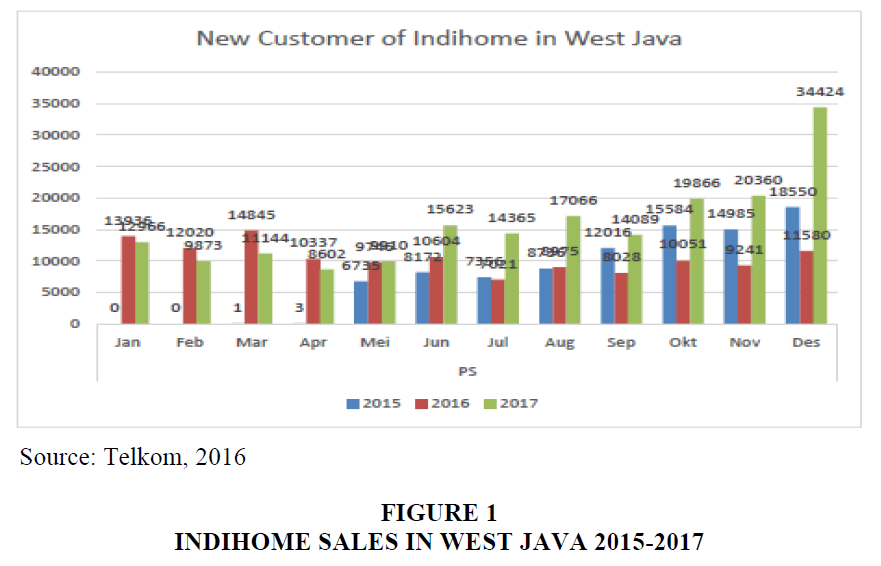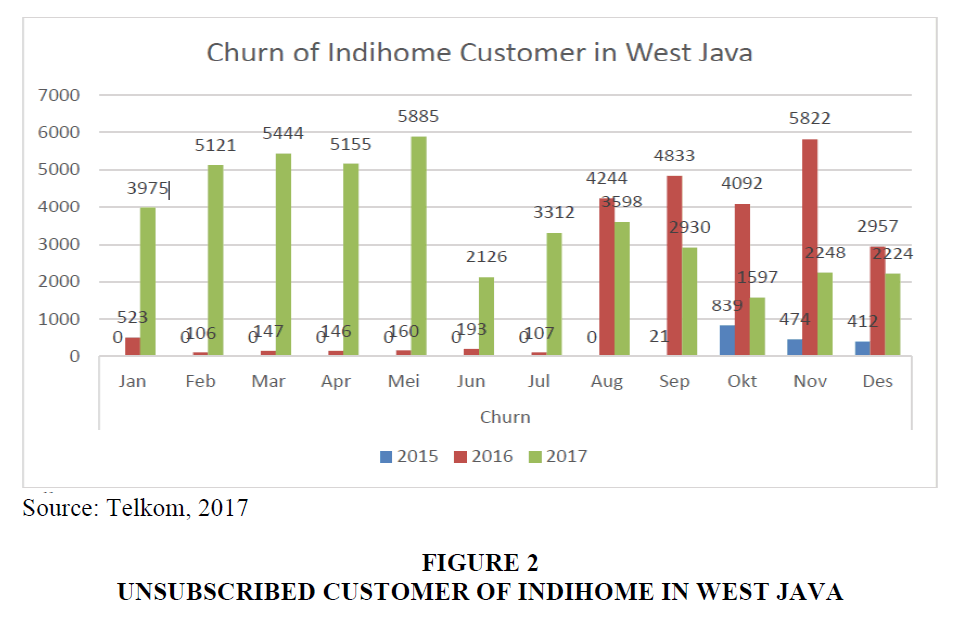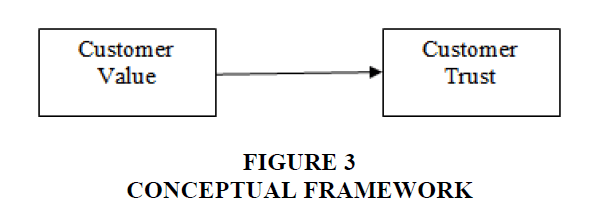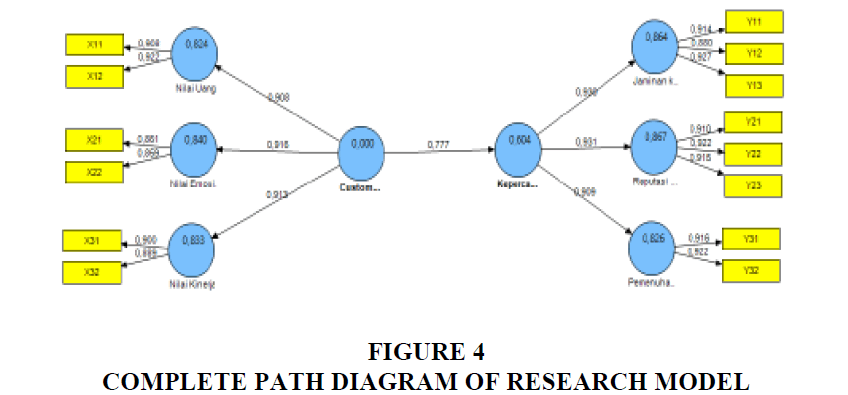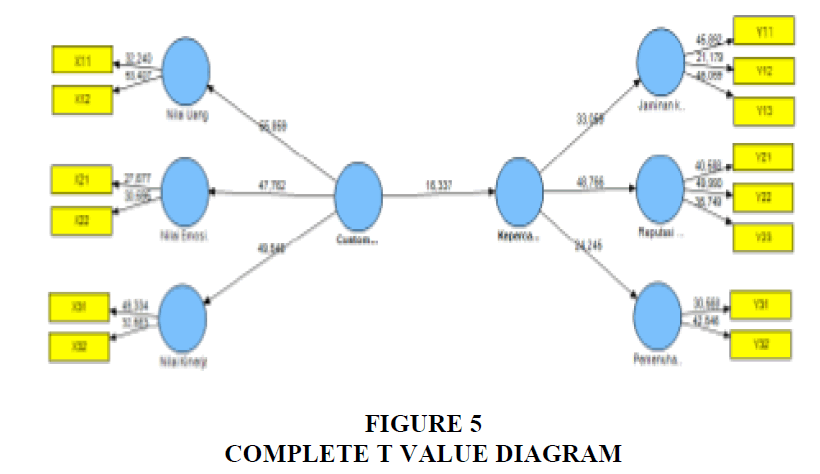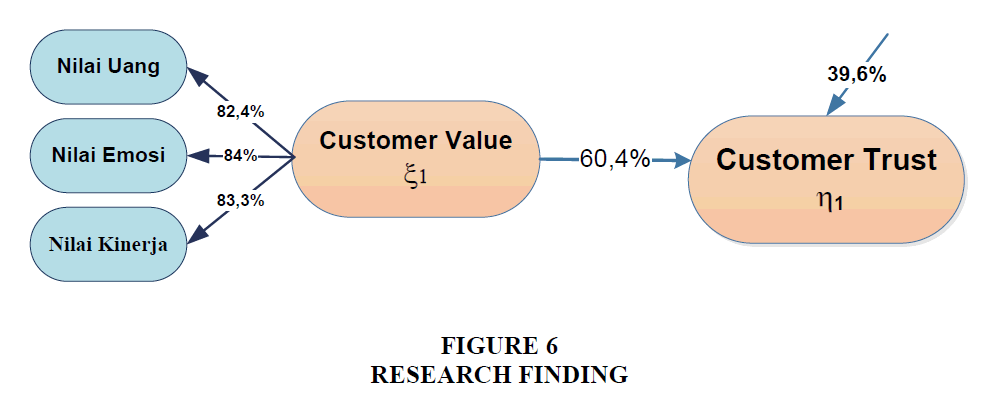Research Article: 2019 Vol: 23 Issue: 4
Customer Value in Improving Indihome Customer's Trust in West Java
Sucherly, Padjadjaran University
Meydia Hasan, Padjadjaran University
Rita Komaladewi, Padjadjaran University
Abstract
The problem facing by IndiHome since this product launched in West Java, is from January 2015 until December 2016 cannot reach sales target. There is a decrease in the number of subscribers from 2015 to 2016. Such conditions indicate a decrease in the level of customer trust towards IndiHome products that are allegedly relate to customer value. So this study aims to examine the influence of customer value on IndiHome customer trust in West Java. The research is conducted by using quantitative method. The population is all IndiHome customers in West Java. This research is dominated by Quantitative Research, namely a research design that approaches empirical studies to collect, analyse and display data in numerical form and tries to accurately measure something. The unit of analysis and observation in this research is IndiHome customer in Bandung City. The observation is conducted in a cross section/one shoot time horizon, meaning that information or data collected directly empirically at one time that is at the end of year 2017. So based on the above description then the population is IndiHome customer in Bandung city and sample size was taken randomly as many as 50 customers taken in a number of INDIHOME service plaza spread in Bandung. The hypothesis is tested by using Partial Least Square (PLS). The result shows that customer value significantly effect on the increasing customer trust. So the results of this study provide implications to the management of PT Telkom as a reference in an effort to increase customer trust through the efforts to increase customer value.
Keywords
customer value, customer trust.
Introduction
Research Background
The digital telecommunication industry is very attractive and promising to be developed. The BPS statistics (2016) reports that in 2015 the total population of Indonesia is 255 million inhabitant, 17% have accessed the internet, the number of families is 65.6 Million, 5.54% owns fixed telephones, 87% owns mobile phones, 36% has the opportunity to access internet. The growths of this sector is relatively stable from year-on-year and survive as a stable sector with the largest growth, 2011-2012 grew by more than 2% and down about 1% in 2013-2014.
The role of the internet especially with broadband services globally determines the growth of the national economy, as well as increasing labour productivity, especially for developing countries. This is in accordance with the results of research conducted to 120 countries that shows a positive effect of increased penetration of various telecommunications services, especially internet services to the economic growth of a country.
However, the performance of internet service in Indonesia is still not meeting the expectations. Until the end of 2016, the internet penetration per 100 populations in Indonesia is generally still below the world average penetration rate, until the year 2016 reached 15.36%, while at the world level reached 38.8%. At the level of Southeast Asia, the teledensity of internet service in Indonesia in general is also still under other neighbouring countries as shown in the Table 1.
| Table 1: Penetration Of Broadband: Fixed And Mobile | |
| Country | Penetration |
|---|---|
| Singapore | 74.18% |
| Malaysia | 65.80% |
| Brunei D | 60.27% |
| Filipina | 36.24% |
| Vietnam | 34.49% |
| Thailand | 26.50% |
| Indonesia | 15.36% |
| Laos | 10.75% |
| Kamboja | 4.94% |
| Myanmar | 1.07% |
PT Telekomunikasi Indonesia, Tbk (Telkom) presents triple play throughout Indonesia through IndiHome service. IndiHome was created to provide quality service and convenience for customers. The Triple Play service includes home phones, Internet on fibber or High Speed Internet and UseeTV Cable (IPTV). Telkom claims that the advantages of high speed internet become a flagship service, because it can transfer data, with bandwidth up to hundreds Mbps beyond the quality of coaxial cable or copper. UseeTV Cable also adds value to Triple Play Telkom service, featuring features such as TV on Demand, Video on Demand, Pause and Rewind and Video Recorder.
IndiHome is a multi-bundling package of Telkom products offering a complete solution for Digital Home Experience which consists of Home Phone+Broadband Internet+Content Packages. Through IndiHome, Telkom seeks to increase the value of each product. With IndiHome, customers can use the home phone freely for local, interlocal or calls to Telkomsel, use broadband internet Speedy with free quota home Wi-Fi, watch favourite shows that can pause, rewind, replay and playback up to 7 days back with UseeTV, as well as music download service, anti-virus and home monitoring. IndiHome is a service that provides the most complete and economical Digital Home Experience.
IndiHome services will continue to grow, given the internal and external factors that are very supportive. The internal factor, Telkom's production equipment that fulfils the existing capacity. Meanwhile, the external factors, namely improving purchasing power in line with the recovery of economy in Indonesia, as well as increasing needs of information and edutainment through the internet.
The problem that is happening now in IndiHome since this product launched in West Java, is from January 2015 until December 2016 cannot reach the sales target, as can be seen from Table 2.
| Table 2: Achievement Of Target And Realization Of Indihome At West Java | |||||
| PSB | |||||
|---|---|---|---|---|---|
| 2015 | TARGET | ACH | 2016 | TARGET | ACH |
| 2,632 | 4,600 | 57% | 13,936 | 12,190 | 114% |
| 7,645 | 8,050 | 95% | 12,020 | 12,190 | 99% |
| 7,991 | 8,050 | 99% | 14,845 | 13,409 | 111% |
| 7,166 | 9,200 | 78% | 10,337 | 9,752 | 106% |
| 6,892 | 9,200 | 75% | 9,746 | 9,752 | 100% |
| 9,666 | 10,350 | 93% | 10,604 | 9,752 | 109% |
| 7,377 | 8,050 | 92% | 7,021 | 7,314 | 96% |
| 8,763 | 9,200 | 95% | 8,925 | 10,971 | 81% |
| 12,016 | 11,500 | 104% | 8,028 | 9,752 | 82% |
| 15,599 | 11,500 | 136% | 10,051 | 9,752 | 103% |
| 14,986 | 12,650 | 118% | 9,240 | 9,752 | 95% |
| 18,550 | 12,650 | 147% | 7,004 | 7,314 | 96% |
| 121,298 | 115,000 | 105% | 123,773 | 121,900 | 102% |
Source: Dashboard Telkom Indonesia
Table 2 above shows that sales targets during January 2015-December 2016 are not achieved. Another problem occurring now in IndiHome is the declining number of IndiHome sales in West Java from January 2015-December 2017, as can be seen at the Figure 1.
Figure 1 shows the new IndiHome monthly installation in West Java from 2015 to 2017. The decreases seen in July 2016, September 2016, October 2016, November 2016 and December 2016, when compared to the same month in the year 2015. Meanwhile, in 2017 did not show an increasing graph in the number of new pairs, but fluctuated, despite a sharp jump from 20,360 in November to 34,424 subscribers in December.
In order to maintain the customer achievement and keep increasing the number of subscribers, it takes a great deal of trust from customers towards telecommunication service providers. Kotler & Kevin (2009) suggests the importance of building trust and customer trust so that they will voluntarily loyal to the company. Customer trust has a very important role in fostering relationships, especially in a service business that is full of risk. This is because in the field of services, the company promises to consumers on the purchase of products that cannot be seen (invisibility product). Meanwhile, telecommunication companies in Indonesia are facing challenges with the increasing number of companies that open the internet and cable network business, so it is necessary to increase the customer's trust namely consumer's subjective belief that the selling party or entity will fulfil the transactional obligation as consumer (Kim & Jihyun, 2009).
The condition, allegedly relates to the issues of the creation of customer value. The company or service provider has provided some customer value to meet the needs of the customers. Customers have maximum value desire, limited by cost, knowledge and income. They form an expectation of value and act on it (Kotler & Keller, 2015). For customers, the value alone is not enough to make the deciding factor so that the feared customers who previously loyal can move to other service providers. Nowadays many customers are affected by some offers from other provider; therefore Telkom Indonesia should be able to anticipate the possibility of shifting customers. However, the disturbance on IndiHome allegedly will reduce the perceived value of customers who allegedly makes customer trust to be reduced.
On the other hand, the decline in customer value is also can be shown from an increase in the number of unsubscribed customers from 2015 to 2017, as can be seen in Figure 2.
Based on the Figure 2 above, can be seen in the 2016, the IndiHome's unsubscribes increased in September and then decreased in October and increased again in November then declined again in December. But conditions continued in January 2017 where there was an increase in the number of unsubscribes up to March which continued to fluctuate until December, however. The highest number of takedowns in 2015 until 2017 occurred in May 2017 of 5885 and in November 2016 were 5,822 units. That means customers do not enjoy the value provided so they decide to unsubscribe IndiHome.
In increasing the customer's trust to the product or service offered to the customer; need to be given value according to customer requirement. Meanwhile, a source from Telkom's dashboard said the targeted target market seen from the segmentation that has been served by the company only mentioned IndiHome is in position P1 that is High Affordability. With higher prices than competitors, it does not necessarily make Telkom Indonesia choose a clear target market to be entered.
On the other hand, the positioning of Telkom Indonesia is formed based on the company's desire to obtain high revenue growth not seen from the needs of customers in making new products, namely speedy which is 2 service that is telephone and internet, replaced with new product named IndiHome. This product is bundling package of 3 services that is telephone, internet and cable television. Because it is bundling, the customer pays the package price for this product, regardless of what the customer needs. For example customer need internet service only but has to pay also for telephone and cable television not used. Compared to similar products from competitors this product's superiority lies in the cable TV service.
Based on this background, it is interesting to study about the influence of customer value on IndiHome customer trust in West Java.
Research Objective
This study aims to examine the influence of customer value on IndiHome customer trust in West Java.
Literature Review
Customer Value and Customer Trust
Soman & Marandi (2010) stated that the main purpose of business is to generate value for its customers. Good marketing capability gives companies the ability to create better customer value (Guenzi & Troilo, 2007). According to Zeithaml (1988) the value of the customer is the overall assessment of the customer for the use of the product based on what perceptions are received and what is given. Woodruff (1997) has the same opinion that is something that customers perceive as a preference for evaluating product attributes, appearance attributes and consequences arising from the use of products to achieve customer goals and objectives in use situations. In their opinion, customer value is defined based on perception and to perform attribute evaluation to achieve goals.
In contrast, Dodds, Monroe & Grewal (1991) stating that customer value is a trade-off between the quality or benefit they receive in the product relative to the quantity incurred by the customer. It is a perceived quality according to the price of the product (Gale, 1994). It is an objective determined by the seller or other stakeholders and the perception process usually involves trade-off between what the customer receives, such as quality and usability and what they sacrifice, such as price, opportunity and maintenance costs and the cost of learning (Slater, 1997). It is based on what the customer receives, such as the quality, the benefits and the usefulness and what they sacrifice, such as price (Day, 1990).
Ballantyne & Varey (2008) have a difference of opinion stating that the consumer value is the capacity to respond dynamically to change customer needs. According to Lehtonen (2011), has a simple equation of: Customer Value=Benefits/Price. Based on that formula, customer value can be improved by improving the benefits of the product/service or reducing the price, which simultaneously raises the benefits and the price is important, but the increase in benefits is far more important than the price increase.
Ulaga & Eggert (2006) argue that customer value is usually defined as a trade-off between benefits and costs incurred by the customer. Klanac (2013) has different opinion that consumer value is a sacrifice and benefits that will be accepted by customers. Woodruff and Sarah (1996) assert that Consumer Value is assessing the results in the trading of positive consequences (benefits) or desired results and the negative consequences (sacrifice) or cost. Some researchers states that consumer value is a perceived customer preference and evaluation of product attributes, appearance attributes and consequences arising from usage to achieve customer goals and objectives in a usage situation.
In contrast, Huber & Stephens (2001) defines consumer value as benefits and costs in terms of customer perceptions of acquisition, consumption and maintenance as well as customer expectations of personal value satisfaction prior to purchase. Others say differently that Consumer Value is an emotional bond formed between customers and producers after customers use products or services produced by the company.
According to Kotler & Kevin (2009), customer value is the difference between total customer value and total customer cost. Total customer value is a set of benefits that customers expect from a particular product or service. The total customer cost is the set of costs expected by consumer to spend, evaluate, obtain, use and dispose products or services. It e is the difference between the value a customer acquires by owning and using a product, at the cost incurred to obtain the product (Best, 2009).
There are some dimensions in measuring customer value; customer's overall assessment (Zeithaml, 1988); product attributes, appearance attributes (Woodruff, 1997); consumer perceptions (Dodds, Monroe & Grewal, 1991); market perceived quality, relative product, price (Gale, 1994); perception, suppliers, assumptions intention (Zeithaml, 1998); quality, benefits and usefulness and what they sacrifice, such as price, opportunity cost and maintenance and cost of learning (Slater, 1997); perceived benefits and perceived costs (Day, 1990); capacity, response, customer need (Ballantyne and Varey, 2008); benefits, costs and exchange (Ulaga and Eggert, 2006); benefit, sacrifice approach, experiential approach complementary (Klanac, 2013); benefits, costs (Woodruff and Sarah, 1996); product attributes, attributes of appearance and consequences (Cristina, 2009); customer perception, maintenance, customer expectations, personal value, satisfaction (Huber & Stephens, 2001); product value and service value (Tsai, Tsai & Chang, 2010); value perception of quality, emotional response, monetary price, behavioural price and reputation (Petrick, 2002); economic value, social value, hedonic value and altruistic value (Papista & Krystallis, 2013).
Based on the description of the concept and dimensions, customer value in this research is measured by: money value, emotional value and performance value.
Regarding the customer trust, Kotler & Kevin (2009) suggests the importance of building trust and customer confidence so that customers will voluntarily loyal to the company. According to Plank, Reid & Pullins (1999) in Kim & Lee (2012), customer trust is defined as the subjective belief of the consumer that the selling party or entity will fulfil the transactional obligation as the consumer understands them. It is the collective subjective belief that exists in terms of behaviour is expected from the trading side (Pavlou, 2002); and a consumer's subjective belief that the selling party or entity will fulfil the transactional obligations as a consumer (Kim & Jihyun, 2009).
According to Sirdeshmukh, Singh & Sabol (2002) customer trust is a consumer's expectation that service provider can be counted on to fulfil its promise. It was suggested that some of the situations and indicators of trust as follows:
1. Probity (focus on trust and integrity and reputation);
2. Equity (related to fair-mindedness, benevolence);
3. Reliability (in relation to the reliability and accuracy and consistency of the product or service expected in some respects related to the warranty issued by the company).
Gambetta (1988) states that customer trust is defined as interpersonal or inter-organizational statements that reflect the extent to which parties can predict each other in order to fulfil their promise in the future in a responsive manner, but also defined as a hope of positive or non-negative results that can be accepted based on the expected action of the company (Bhattacharya, Devinney & Pillutla, 1998).
Customer trust is dependent on the competence and willingness and sincerity to maintain relationships with consumers, compared to make mistakes in a way to maintain consumer confidence (Baier, 1986); emotion that affects buyers where there will be a feeling of security or insecurity about the seller and a belief about the seller's confidence in a situation where the buyer faces some risk if the seller is unreliable.
There are several dimensions of customer trust : consumer's subjective beliefs, collective subjective confidence and consumer's subjective beliefs (Plank, Reid & Pullins, 1999; Pavlou, 2002; Kim & Jihyun, 2009); consumer expectations (Sirdeshmukh, Singh & Sabol, 2002); consumer Beliefs (Schurr & Ozanne, 1985, in Roland & Werner, 2010); interpersonal, inter-organizational state, responsive behaviour and uncertain future (Gambetta, 1988); positive (or non-negative) dimension (Bhattacharya, Devinney & Pillutla, 1998) interpersonal state and inter-organizational state (Baier, 1986); consumer emotion and affect; organization, employee and goods and services (Chamchuntra & Fongsuwan, 2014).
Based on the description of the concept, customer trust in this research is measured with quality guarantee, company reputation and fulfilment of promise.
Several researchers found the influence of customer value on customer trust. Lin, Wang & Huang (2011) found that (1) quality of service has a significant positive effect on perceived value; (2) quality of service has a significant positive effect on customer trust; (3) promotion strategy has a significant positive effect on perceived value; (4) promotion strategy has significant positive effect to customer's trust; (5) perceived value has a significant positive effect on customer satisfaction; (6) Customer trust has a significant positive effect on customer satisfaction. Coulter & Coulter (2002) found the impact of service characteristics on greater trust if there are longer relations. Raza & Rehman (2012) found that customer satisfaction is mainly influenced by the quality of service.
Based on the description above and then proposed hypotheses as follow:
H customer value effects on IndiHome customer trust in West Java
Conceptual Framework
Based on the description of the concept above, then the conceptual framework is arranged as follows Figure 3:
Methodology
This research is dominated by Quantitative Research, namely a research design that approaches empirical studies to collect, analyse and display data in numerical form and try to accurately measure something (Cooper & Schindler, 2006).
The unit of analysis and observation in this research is IndiHome customer in Bandung City. The observation is conducted in a cross section/one shoot time horizon, meaning that information or data collected directly empirically at one time that is at the end of year 2017. So based on the above description then the population is IndiHome customer in Bandung city and sample size was taken randomly as many as 50 customers taken in a number of INDIHOME service plaza spread in Bandung. The hypothesis is tested by using Partial Least Square (PLS).
Results and Discussion
Goodness of Fit-Outer and Inner Model
There are two sub models in a structural equation model; the inner model specifies the relationships between the independent and dependent latent variables; and the outer model specifies the relationships between the latent variables and their observed indicators.
Inner Model
Analysis of the structural model (inner model) shows the relationship between the latent variables in the study. Inner models is evaluated by using R Square and Prediction relevance (Q square) from Stone-Geisser's with a blindfolding procedure. Referring to 1998’s data, the R square values of 0.67 (strong), 0.33 (medium) and 0.19 (weak) and Prediction relevance 0.02 (minor), 0.15 (medium) and 0.35 (big).
The Table 3 above shows the value of R2 on customer value as the endogenous variable is in the high/strong criterion (>0.67) and the Q square value is in the big criterion (>0.35), so it can be concluded that the research model is supported by empirical condition or model fit.
| Table 3: Test Of Outer And Inner Model | |||||
| AVE | Composite Reliability | Cronbachs Alpha | R Square | Q square | |
|---|---|---|---|---|---|
| Customer Value | 0.659 | 0.920 | 0.896 | 0.659 | |
| Customer trust | 0.713 | 0.952 | 0.942 | 0.604 | 0.661 |
Source: SmartPLS 2.0
To check convergent validity, each latent variable’s Average Variance Extracted (AVE) is evaluated. From Table 3, it is found that all of the AVE values are greater than the acceptable threshold of 0.5, so convergent validity is confirmed.
Outer Model
An outer model analysis is used to test the validity and reliability of the latent variables and the dimensions measured by the indicators. Measurement Model is explained by Cronbachs Alpha to know the reliability of indicators in measuring dimensions and latent variables. If the value of Cronbachs Alpha is greater than 0.70, it shows that dimensions and indicators are reliable in measuring variable. Table 3 shows that Composite reliability and Cronbachs Alpha from variable >0.70, so that the variables and dimensions in the model meet the discriminant validity criteria. And finally stated that all variables have a good reliability.
The Table 4 shows the result of measurement model for each dimension on indicator. The result of measurement model of dimensions by its indicators shows that the indicators are valid which the value of t<2.05 (t-table at α=0.05). The result of measurement model of latent variables on their dimensions show to what extent the validity of dimensions in measuring latent variables.
| Table 4: Loadingfactor Of Latent Variable-Dimension-Indicator | |||
| Indicator-Dimension | l | SE | t-value |
|---|---|---|---|
| Customer Value->Money Value | 0.908 | 0.016 | 55.859* |
| X11<-Money Value | 0.908 | 0.028 | 32.240* |
| X12<-Money Value | 0.922 | 0.017 | 53.407* |
| Customer Value->Emotional Value | 0.916 | 0.019 | 47.762* |
| X21<-Emotional Value | 0.861 | 0.031 | 27.677* |
| X22<-Emotional Value | 0.859 | 0.028 | 30.595* |
| Customer Value->Performance Value | 0.913 | 0.018 | 49.546* |
| X31<-Performance Value | 0.900 | 0.018 | 49.334* |
| X32<-Performance Value | 0.889 | 0.027 | 32.563* |
| Customer Trust->Quality Guarantee | 0.930 | 0.028 | 33.059* |
| Y11<-Quality Guarantee | 0.914 | 0.020 | 45.892* |
| Y12<-Quality Guarantee | 0.880 | 0.042 | 21.179* |
| Y13<-Quality Guarantee | 0.927 | 0.020 | 46.059* |
| Customer Trust->Company Reputation | 0.931 | 0.019 | 48.766* |
| Y21<-Company Reputation | 0.910 | 0.022 | 40.588* |
| Y22<-Company Reputation | 0.922 | 0.018 | 49.990* |
| Y23<-Company Reputation | 0.915 | 0.026 | 35.749* |
| Customer Trust->Fulfilment of Promise | 0.909 | 0.037 | 24.245* |
| Y31<-fulfilment of Promise | 0.916 | 0.030 | 30.568* |
| Y32<-fulfilment of Promise | 0.922 | 0.022 | 42.546* |
*valid for a=0.05
Figures 4 and 5 shows the complete path diagram.
Structural Model
Based on the research framework and then obtained a structural model as follow:

Where
η1 = Customer trust
 = Customer Value
= Customer Value
 = Residual
= Residual
Hypothesis Testing
Below is the result of partial testing of hypothesis Table 5.
| Table 5: Partial Testing Of Hypothesis | ||||
| Hypothesis | g | t | R2 | Conclusion |
|---|---|---|---|---|
| Customer Value-> Customer Trust | 0,777 | 16,337* | 0,604 | Hypothesis accepted |
* Significant at a=0.05 (t table=2.05)
The table show that partially, customer value influential significantly to customer trust for 60.4%.
Research Finding
Based on hypothesis testing result, Figure 6 describes the research model finding.
The results show that customer value proved to affect IndiHome customer trust in West Java. Emotional value gives more influence than the performance and money values in increasing the trust of IndiHome customers in West Java. Emotional value is obtained when there is a match between the product and the customer's self-image and the customer feels a match between the product and the customer's taste. Performance value indicates the level of customer satisfaction over the service. The value of money shows the customer's perception of the price and its compatibility with products and features. Customer trust indicates the existence of quality guarantee, company reputation and fulfilment of promise. Customer trusts the quality guarantee if they trust that the operator guarantees of good product quality, facilitates the use of the product and reliability of the product. The company's reputation shows how far the customer's perception of the product's reputation from the operator, operator’s service and product integrity. Customer trust in fulfilment of operator's promise is reached if the operator has the proven product characteristics and the same product capability to all customers.
The results of this study are thus in line with Lin, Wang & Huang (2011) who found that service quality significantly positively affects customer trust; Coulter & Coulter (2002) who found the impact of service characteristics on greater trust if there were longer relations; and Raza and Rehman (2012) who found that customer satisfaction is primarily influenced by the quality of service.
Conclusion and Recommendation
The result shows that customer value significantly affects the trust of IndiHome customers in West Java. Increased customer trust is mainly influenced by increased customer value in the form of emotional value, followed by performance value and value for money. This research provides implications to the management of PT Telkom as a reference in an effort to increase customer trust through the efforts in increasing customer value.
References
- Baier, A. (1986). Trust and anti-trust. Ethics, 96(2), 231-260.
- Ballantyne, D. & Varey, R.J. (2008). Service-dominant logic of marketing. Journal of the Academy of Marketing Science (JAMS), 36(1), 11-14.
- Best, R.J. (2009). Market-based management. Strategies for growing customer value and profitability. Pearson International Edition.
- Bhattacharya, R., Devinney, T.M. & Pillutla, M.M. (1998). A formal model of trust based on outcomes. Academy of Management Review, 23(3), 459-472.
- Chamchuntra, S. & Fongsuwan, W. (2014). Influencing variables on outsourcing repeat purchase intention by Thailand’s Kasikorn Bank PCL. Research Journal of Business Management, 8, 319-337.
- Cooper, D.R. & Schindler, P.S. (2006). Business research methods. McGraw-Hill International Edition.
- Coulter, K.S. & Coulter, R.A. (2002). Determinants of trust in a service provider: the moderating role of length of relationship. Journal of Services Marketing, 16(1), 35-50.
- Cristina, H. (2009). Collaborative shopper consumer value. Creation represents the objectives of CM and demand strategy and capabilities. The International Review of Retail, Distribution and Consumer Research, 19(3), 199-218.
- Day, G.S. (1990). Market driven strategy. The Free Press, New York, NY.
- Dodds, W.B., Monroe, K.B. & Grewal, D. (1991). Effect of price, brand and store information on buyers’ product evaluations. Journal of Marketing Research, 28(3), 307-319.
- Gale, B.T. (1994). Managing customer value: Creating quality and service that customers can see. New York, NY: Simon & Schuster.
- Gambetta, D. (1988). Trust: Making and breaking cooperative relations. Oxford: Blackwell.
- Guenzi, P. & Troilo, G. (2007). The joint contribution of marketing and sales to the creation of superior customer value. Journal of Business Research, 60(2), 98-107.
- Huber, E. & Stephens, J. (2001). Development and crisis of the welfare state: Parties and policies in global markets. Chicago: University of Chicago.
- Kim, H.H. & Jihyun, K. (2009). The effect of offline brand trust and perceived internet confidence on online shopping intention in the integrated multi-channel context. International Journal of Retail & Distribution Management, 37(2), 126-141.
- Kim, S. & Lee, J. (2012). E-participation, transparency and trust in local government. Public Administration Review, 72(6), 819-828.
- Klanac, N.G. (2013). An integrated approach to customer value: A comprehensive-practical approach. Journal of Business Market Management, 6(1).
- Kotler, P. & Keller. (2015). Marketing management. Pearson education.
- Kotler, P. & Kevin, L.K. (2009). Manajemen pemasaran jilid, edisi Ketiga Belas. Terjemahan Bob Sabran, MM. Jakarta: Penerbit. Erlangga.
- Lehtonen, S (2011). Towards resolving the complete fern tree of life. PLoS One, 6(10), 24-851.
- Lin, L.Y., Wang, J.F. & Huang, L.M. (2011). The impacts of service quality, promotion strategy, perceived value and customer trust on customer satisfaction: An example of the taxpayer’s of Taipei country tax bureau. Marketing Review, 8(4), 433-452.
- Papista, E. & Krystallis, A. (2013). Investigating the types of value and cost of green brands: Proposition of a conceptual framework. Journal of Business Ethics, 115(1), 75-92.
- Pavlou, P.A. (2002). Evidence of the effect of trust building technology in electronic markets: Price premiums and buyer Behavior. MIS Quarterly.
- Petrick, J.F. (2002). Development of a multi-dimensional scale for measuring the perceived value of a service. Journal of Leisure Research, 34, 119-134.
- Plank, R.E., Reid, D.A. & Pullins, E.B. (1999). Perceived trust in business to-business sales: A new measure. Journal of Personal Selling and Sales Management, 19(3), 61-71
- Raza, A. & Rehman, Z. (2012). Impact of relationship marketing tactics on relationship quality and customer loyalty: A case study of telecom sector of Pakistan. African Journal of Business Management, 6(14), 5085-5092.
- Roland, K., Werner, H.K. (2010). Consumer trust in service companies: A multiple mediating analysis. Managing Service Quality: An International Journal, 20(1), 4-25.
- Schurr, P.H. & Ozanne, J.L. (1985). Influence on exchange processes: Buyers' preconceptions of a seller's trustworthiness and bargaining toughness. Journal of Consumer Research, 11(4), 939-953.
- Sirdeshmukh, D., Singh, J. & Sabol, B. (2002). Consumer trust, value and loyalty in relational exchanges. Journal of Marketing, 66, 15-37.
- Slater, D. (1997). Slater consumer culture and modernity. Cambridge: Polity Press
- Soman, D. & Marandi, N.S. (2010). Managing customer value: One stage at a time. Front cover, World Scientific.
- Tsai, M., Tsai, C. & Chang, H. (2010). The effect of customer value, customer satisfaction and switching costs on customer loyalty: An empirical study of hypermarkets in Taiwan. Social Behaviour and Personality: An International Journal, 38, 729-740.
- Ulaga, W. & Eggert, A. (2006). Value-based differentiation in business relationships: Gaining and sustaining key supplier status. Journal of Marketing, 70(1), 119-136.
- Woodruff, R.B. & Sarah, F.G. (1996). Know your customer: New approaches to understanding customer value and satisfaction. Cambridge, MA: Blackwell Publications.
- Woodruff, R.B. (1997). Customer value the next source of competitive advantage. Journal of the Academy of Marketing Science, 25, 139-153.
- Zeithaml, V.A. (1998). Consumer perceptions of price, quality and value: A means-end model and synthesis of evidence. Journal of Marketing, 52(3), 2-22.
